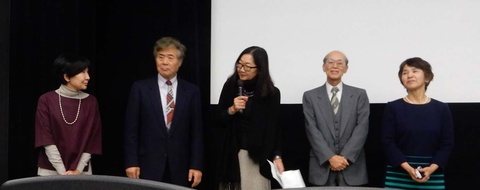When can we expect to see Tohokuno Shingetsu here in Canada?
Hopefully this fall at the Vancouver International Film Festival. We will enter our film in the film festival and hopefully get selected for their programming. That is planned to be the 2016 Canadian premiere.
The reality is…many good films are being made these days all over the world and there is no guarantee that one’s film will be noticed. Sundance Festival had 12,793 film entries this year with only 122 features selected and programmed. The competition is extremely difficult with those kinds of numbers. But we will try our best and hope we have some luck. The film is good, it just needs to be seen.
What notable features distinguish this film from others then? Why should it be selected?
No. I can’t answer that. It’s a piece of art from an independent filmmaker…so it’s my heart joined with those from Tohoku. So, I cannot say why this film should be selected over others. Each work of art has its merits. It’s up to the audience to answer this question.
You’ve shown it in Sendai already. What was the response there like?
I held “sneak previews of the incompleted film work in progress” to a selected audience in Sendai and at the Canadian Embassy theatre in Tokyo. Both screenings were incredibly emotional.
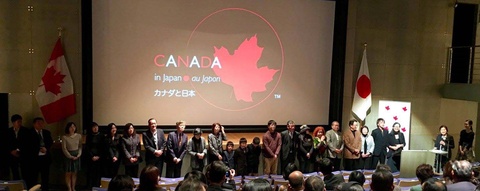
Photo courtesy of Taka Yamamori.
I was surprised at the strong response from the Japanese and Tohoku audiences. When the preview ended and the lights went up…someone in the audience started to sing Furusato (a song sung in Tohoku no Shingetsu). That single voice inspired other voices to sing too…until everyone was on their feet singing for the Tohoku survivors in the film who stood at the front of the theatre with me.
Needless to say, there wasn’t a dry eye in the house. What a beautiful, beautiful send-off for our film. There is a buzz happening…people who have seen the film think it is an important film, especially in Japan.
So many films and projects get started but never make it to the finish line. So, I am just very grateful that we have come to the finish line of this marathon. And now it is up to the audiences.
Can you tell us who has been involved in the documentary both here and Japan? There are some famous Japanese actors who we might know?
Japan Academy Award winning actress Tamiyo Kusakari of Shall We Dance offered to do the Japanese narration for Tohoku no Shingetsu which was done in a recording studio in Onomichi. Although Tamiyo lives in Tokyo, she graciously made the trip to Onomichi to record a wonderful narration track. I am very lucky to have her talents and support for this film.
Tamiyo’s husband is noted Japanese director, Masayuki Suo. He has been giving us behind-the-scenes support and experience which money cannot really buy.
All in all, I have been very lucky that so many generous and talented people joined this project. I am very grateful to all of them.
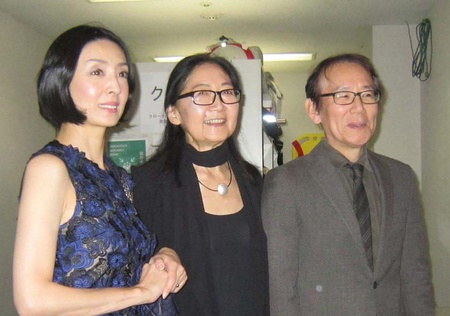
Photo courtesy of Tsutomu Nambu.
* * * * *
Surviving Five Years Later…
Can you give us an update on what is happening with the 3.11 survivors? How well or not are they coping? Is the situation there better than it was a year ago?
In September, after locking the picture edit part of the film, I went to Japan for a series of lectures (to start promoting the film and to earn some money to continue making this film!). While I was there, I travelled to Tohoku through Iwate, Miyagi, and Fukushima prefectures to make contact with, say “hello” to people, and check up on all the friends I’ve made since 2011. And also to show them their part of the film before the public would see it.
I had been away from Japan for almost two years, busy editing the picture in Vancouver and keeping in touch with Tohoku people only through emails. After the two-year absence, I was expecting to see some big changes in their lives and conditions. BUT, I was a little shocked and saddened to see how slow some of the progress has been.
Almost all the people I interviewed (over 80 people) who lived in kasetsu (temporary housing) in 2011 are still living in them today. Just a handful (two or three families) have been lucky enough to leave the “kasetsu life” and move into a house again. The rest are living in small, clustered, and often remote kasetsu camps. Japanese law for kasetsu states that temporary housing for disaster victims are built to be lived in for two years. They are now going into over five years.
If I am disappointed, I can only imagine what they must be feeling.
Depending on where you go, the progress or lack of progress differs, from the northern fishing town of Otsuchi in Iwate, to the abandoned ghosts towns like Odaka near the nuclear power plant in Fukushima…the progress is different.
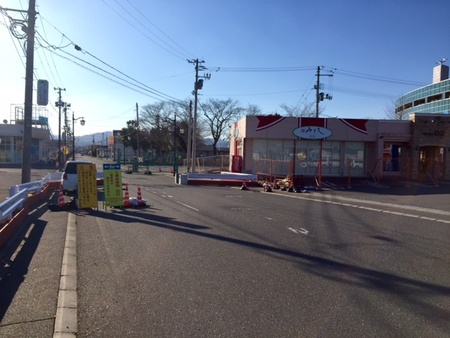
How so?
Victims are very patient and forgiving and many have found joy in very simple, but profound ways. Statistics do show that emotional stress and depression is one of the leading problems facing survivors in 2016.
What can we do here in Canada/USA to help the survivors?
Not forget them. Try to understand them. Learn from them. See and live our own lives more clearly.
Help is not so much about money donations any more. It’s more about listening and expressing care. In fact, many Tohoku people are ashamed of handouts and feel their pride has been diminished. Tohoku people are people who know how to make things from nature and scratch. Tohoku people know how to share half of what they have with others. These are at the core of the Tohoku spirit.
These are the things that I saw over these five years with the Tohoku pople and learned to see in my own life again.
Can you share some of the stories?
I will leave this up to the audience to discover when they see Tohoku no Shingetsu. It is a human story, not only a story about Tohoku people. It is a story about Japanese customs and traditions, both the good and bad parts. It is a story about love and each other.

Photo courtesy of Linda Ohama.
What has this personal journey been like?
Incredible. Incredible learning: the language, Tohoku, the Japanese culture. Incredible challenge: physically, financially, and mentally. Incredibly fulfilling: meeting and knowing so many amazing human beings exist. Incredible relief to be finished “making” the project. Incredibly nervous about whether or not we will get an audience for the voices of Tohoku. These and more. But one word fits all: an incredible journey.
What still needs to be done? Any appeals?
Lots still to try and do.
What are your hopes for the doc at this point?
The first film festival. The Tohoku screenings. Finding audiences. Support for the Tohoku people.
Why is 3.11 still important to remember in 2016?
It reminds us all to appreciate life, nature, and each other every day.
“Shingetsu” means a new moon in Japanese, the moon that we cannot see in the night sky even though it’s there. It is like Tohoku and life itself. There are so many things in life that we can’t see, but only feel if we take notice. These can be the most wonderful, joyful, and pure things in our day, but sometimes we’re too busy or too preoccupied to notice. There is so much to appreciate and so much to be grateful for, even when you are left with what seems like nothing.
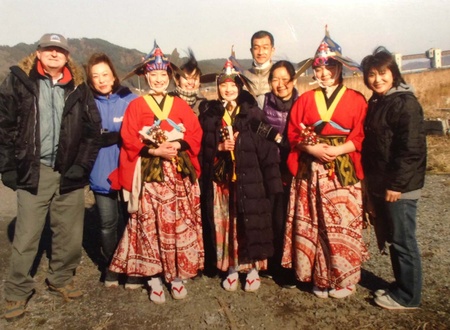
For more information go to www.lindaohama.com.
© 2016 Norm Ibuki


